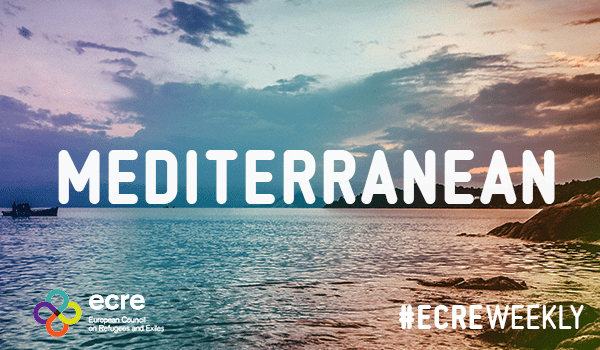More than 800 survivors onboard the German search and rescue vessel Sea-Eye 4 have finally been allowed disembarked in Trabiani in Sicily. 306 people onboard the Ocean Viking were given permission to dock in Sicily but 250 people remain on the boat due to disembarkation delays. Interception and return to unsafe Libya continues. Another group of Syrian nationals have arrived in Italy from Lebanon through the humanitarian corridor as the Italian interior ministry confirms that Afghans in need of protection will also be resettled via similar schemes.
800 people including some 200 children and five pregnant women saved by the civilian search and rescue vessel Sea-Eye 4 in several operations were finally granted permission by Italian authorities to disembark in Sicily on 7 November after several days at sea. The authorisation came just hours after a vessel from Mission Lifeline assisting during rescues had delivered food and blankets to the survivors in dire need onboard Sea-Eye 4.”We are relieved and overjoyed that the difficult hours for our crew and the rescued people will end on Sunday and that the people will finally be safe in Italy,” stated Gorden Isler from Sea-Eye, the organisation that operates the vessel. Despite the fact that the dramatic rescue of 400 people onboard, several of whom were rescued from the water, took place inside the Maltese SAR zone, authorities from Malta remained unresponsive. Meanwhile, 250 survivors continue to wait onboard the Ocean Viking – operated by SOS Méditerranée in partnership with the International Federation of Red Cross and Red Crescent Societies (IFRC) – after the disembarkation in Augusta, Sicily, was put on stand-by on 11 November. Unaccompanied children and a few families were able to get off the ship. The remaining people were, according to the organisation, set to “endure another night on board in torrential rain”. SOS Méditerranée have reported that “psychological and physical conditions of survivors worsen by the hour” and stated on 10 November that the hundreds of people were forced to spend the night “in a storm with 2-m waves washing over the deck” and “soaked blankets, plastic survival bags running out, survivors shivering in the cold”.
The International Organization for Migration (IOM) reports that 1,085 people were intercepted and returned to Libya between October 31 and 6 November. Almost 29,000 people have been returned so far in 2021. Since a violent and deadly crackdown by Libyan authorities in October, thousands of people on the move have camped outside the UN Refugee Agency (UNHCR) centre in Tripoli to demand evacuation. The centre remains closed due to security concerns and according to UNHCR, the agency currently: “has no alternative housing for the thousands of asylum seekers and refugees stranded in Libya”. UNHCR is “trying to identify solutions to alleviate their terrible plight, but have very limited operational ability on the ground due to the lack of agreement with the host country, lack of visas for our staff and lack of security”. Further, the agency notes that it has: “repeatedly advocated for the release of asylum seekers and refugees and deplored conditions in detention centres, which are often overcrowded, lack basic sanitation facilities and where human rights abuses have been well-documented – most recently by the Independent Fact-Finding Mission on Libya. Despite laudable attempts by some Libyan authorities, such as the Attorney-General’s Office, little progress has been made”. On 5 November, 172 asylum seekers were evacuated in the first repatriation flight to Niger from Libya in more than a year. UNHCR stated: “Many of those evacuated had previously been detained in extremely dire conditions, were victims of trafficking or had experienced violence in Libya”. However, “considering the limited number of places, evacuation can only be a solution for extremely vulnerable people, in urgent need of security and protection”.
On 5 November, 44 Syrian refugees including 15 children arrived in Rome through humanitarian corridors implemented by the Community of Sant’Egidio, the Federation of Evangelical Churches in Italy and the Tavola Valdese. The scheme isapproved by the Italian Ministries of Interior and Foreign Affairs, and according to Sant’Egidio: “Since February 2016, with the Humanitarian Corridors more than 2050 refugees have arrived in Italy from Lebanon”. Further, 1,200 Afghans in need of international protection will be accepted by Italy through humanitarian corridors under an agreement signed on 4 November. “Humanitarian corridors must not be relegated to the space of emergency welfare assistance, charity but should be a good practice for Europe when it will decide to deal with something that isn’t a temporary emergency but a momentous turning point,” said the president of the Federation of Evangelical Churches (Fcei).
For further information:
- ECRE, Med: Hundreds Saved at Sea, Media Claim Calabria is “the New Lampedusa”, Pope Condemns Returns to Libya, Evacuations from Libya Resume, October 2021
- ECRE, Med: 500 People Await Disembarkation, NGO Acquitted for Refusing Libya Return, Boat-Drivers Scapegoated in Italy, Tragedy off Tunisia and Empty Boats Raise Shipwreck Fears, October 2021
Photo: ECRE
This article appeared in the ECRE Weekly Bulletin. You can subscribe to the Weekly Bulletin here.

